 How much money is being boring costing you?
How much money is being boring costing you?
ANSWER: Too much.
Boring ideas lose.
Boring people fade.
Boring organizations fizzle.
LESSON LEARNED: There is inverse relationship between how successful you are and how boring you are.
Seth Godin talked about this at length in a recent podcast with Ductape John:
“If the marketplace isn’t talking about you, there’s a reason,” Seth says. “If people aren’t discussing your products, your services, your cause, your movement or your career, there’s a reason. The reason is that you’re boring.”
This reminds me of the movie American Beauty. Towards the end, Ricky (the outcast) finally shoots down Angela (the popular girl) by evoking her deepest fear: That she’s normal.
“You’re boring. And you’re totally ordinary. And you know it,” Ricky says.
Devastated, Angela storms out of the room.
Ouch.
What about you?
Are YOU normal? Do your customers perceive you as normal?
Hope not. Your business depends on it.
Today we’re going to explore a list of thirty ways to become the most interesting person you know. As someone who makes a living writing books about “not BEING normal,” (as well as being pretty abnormal himself!) each of these practices comes from my direct experience, observation, research and reflection.
1. Avoid the Always/Notice the Never. Find out what people who do what you do ALWAYS do, then do the opposite. Similarly, find out what people who do what you do NEVER do, then do the opposite. Here’s a helpful video module with an exercise you can implement to make this practice happen. What are you currently doing that’s unpredictable?
2. Make the mundane memorable. What do your voicemail, email signature, business card, website and blog have in common? ANSWER: They’re all boring. Keep in mind: Nobody notices normal. Nobody buys boring. And nobody pays for average. So, the secret is to create a seamless predictability among all marketing touchpoints. All of these are underused branding hotspots (and more!) require a unique touch. How many customers is being boring costing you?
3. Don’t be one-dimensional. I once had a boss whose sole interest, purpose and passion in life was sports. That’s it. The guy couldn’t carry conversation like a normal person unless the topic related to sports. Or, if the conversation was not about sports, he’d go out of his way to make sure it slowly became that way.
THEE most uninteresting, one-dimensional guy I ever worked with.
Now, I’m not against having a passion for sports. I love sports. (Go Cardinals!) What IS as a problem, however, is when you maintain such a limited worldview and openness for activities and experiences outside of your scope of interest, that is mars your ability to relate to others in a healthy way. Bor-ring. How many dimensions do YOU have?4. Learn the principles of amazing storytelling. Stories are powerful. Stories are better than statistics or quotes. Stories are what customers; readers and audiences remember and connect with most. Ultimately, stories are the best way to communicate a message. So, if you want to become a master storyteller, my suggestions are: (1) Listen to Garrison Kiellor, (2) Read Made to Stick and (3) Attend Doug Stevenson’s Story Theater program. How many people are repeating YOUR story?
5. Be a story distiller. BUT, you can’t just tell the story. Because that’s not enough. So, when your story is over, don’t just move on to the next story. First, figure out the lesson(s), universal human experience/emotion, practical take home value and Call to Action. Here’s a helpful article on how to extract take-home value. Why are you telling this story?
6. Be a Smokin’ Hot Piece of Brain Candy. One of Edward DeBono’s most underrated books is called How to Have a Beautiful Mind. In the opening he states: “As you get older, physical beauty tends to fade. But beauty of the mind is independent of age and can actually increase with wisdom and experience.”
In short: Be Brain Candy.
This idiom of psychological attractiveness means “someone with high mental appeal AND significant substance.” It’s more enduring, attractive, marketable, approachable, memorable and, of course, more INTERESTING. Check out my Top Twenty List of Smokin’ Hot Pieces of Brain Candy. Are you eye candy or brain candy?
7. Be childlike, but not childish. One person’s playful spirit brings out the same in another. So, by acting childlike, you subconsciously give other people PERMISSION to the same. It’s contagious. It’s approachable. It’s memorable. And everyone can relate to it. How are you giving people permission to be playful around you?
8. Be more challenging. Ask questions like: Is that always the case? So what? What stops you? What would happen if you didn’t? What’s your proof? Break people’s patterns. Make them stop, think and say, “Wow…” It works. How challenging are you?
9. Be radically honest. It’s unexpected and unforgettable. Read this life-changing book and, if you practice what Brad practices, I guarantee you’ll become twice as interesting of person by the time you’re done. How are you branding your honesty?
10. Become a Question Master. It’s not just about asking a bunch of questions; it’s about valuing a questioning attitude. So, every time you hear or read a question that makes you react in ANY way, write it down. Add it to your running list of questions. Categorize them. Sort them alphabetically to make it easier on your eyes. My list has 6000. How many questions do you have on your list?
11. Books. Speaking of books, I suggest you make a list called, “Top Ten Most Interesting Books I’ve Read.” Next to each one, write three attributes, actions or states of being that make those books so interesting. When you’re done, look for patterns. Extract the key ideas and then ask yourself how you can practice that in your own life. What did you read today?
12. Consciously choose how you experience the world. In his mind-blowing book, Playful Perception, Herbert Leff suggests, “Expand your repertoire of useful awareness plans and you will improve the flavor and value of your inner experiences. Increase the choice about the quality of your experience.” Check out this awesome list of 43 awareness plans to make your daily life more interesting. Are you making mindful choices for experiencing the world?
13. Create Points of Dissonance. Vagueness stimulates curiosity. And curiosity is a natural motivator of human engagement. So, there’s a certain dissonance when people observe an unexpected or unexplained behavior. Especially when it’s inconsistent with their environment. (Like seeing some guy wearing a nametag at the gym, for example.)
The challenge is to craft an idea, a message, or a look that when people are first exposed to it, they can’t help but respond with, “Huh?” or “Ok, so, I just HAVE to ask…” Those words are money in the bank. Remember: The most effective way to attract people’s attention is to B-R-E-A-K their patterns. Copyblogger has a killer post about being interesting as it relates to this topic. What patterns are YOU breaking?
14. Establish your voice. If you want make your thinking, writing and speaking more unique, relevant, persuasive, memorable, appealing and more creative, you need to pull material FROM, and cite examples USING multiple, eclectic and personal sources.
In the words of Kurt Vonnegut: “If you want to be a great writer, be a great date for your reader.” Here’s a meaty, practical guide on how to do this. WARNING: If you’re an Oprah fan, you may not want to read it. Is your writing innovative or imitative?
15. Expand your references. In the book Unlimited Power, Tony Robbins said, “Limited references create a limited life. If you want to expand your life, you must expand your references by pursuing ideas and experiences that wouldn’t be a part of your life if you didn’t consciously seek them out.”
Remember: The more interesting experiences you have, the more interesting people you meet, the more interesting things you see, watch, hear, read, taste, the more interesting places you go, the more interesting you will become. Everything is a plus. How have you stepped out of your comfort zone this week?
16. Explore the word “interesting.” It literally means: Engaging or exciting and holding the attention or curiosity. Arousing a feeling of interest. A state of curiosity or concern about or attention to something. Involvement with or participation in something. An excess or bonus beyond what is expected or due. Something, such as a quality, subject, or activity that evokes this mental state.
OK, so, now that you know that, go do that. Go BE that. On a scale from 1-10, how interesting would you say you are? How interesting would your top 20 customers say you are?
17. Extract the positive characteristics. Make a list called, “Top Ten Most Interesting People I Know.” Next to each one, write three attributes, actions or states of being that make those people so interesting. When you’re done, look for patterns. Extract the key ideas and then ask yourself how you can practice that in your own life. This exercise is how I began writing this very module on being interesting. It works and it’s fun. What would an interesting person do in this situation?
18. Extract the negative characteristics. Next, make a list called, “Top Ten Least Interesting People I Know.” Next to each one, write three attributes, actions or states of being that make those people so uninteresting. When you’re done, look for patterns. Extract the key ideas and then ask yourself how you can practice the opposite of in your own life. What would an uninteresting person do in this situation?
19. Fascinate yourself with the ordinary. “Evaluate critically every novelty you encounter,” Mihály Csíkszentmihályi wrote in his amazing book Creativity. “One of the surest ways to enrich life is to make experiences less fleeting.” If you do this, you WILL boost your creativity. You will flood your mind with new ideas. You will build a solid foundation of curiosity. And the combination of those three results will mold your melon into an attractive, valuable commodity that your clients will want to have access to.
Remember: Clients don’t want to hire consultants or marketers or coaches – they want to hire cool, smart people who happen to do those things. What ordinary stuff fascinates you?
20. Find interesting in almost anything. Similarly, Edward DeBono encourages people to embrace curiosity by constantly saying, “Now that’s interesting…”“Be able to find interest in almost anything,” DeBono says in the aforementioned How to Have a Beautiful Mind. “Be curious. Explore things. Bring up a discussion. Get people’s opinions, ideas and values. Explore, elaborate and make connections.” Are you practicing that enough?
21. Gain an eclectic education. In his book, The Invaluable Leader, my friend Dale Furtwengler suggests, “Gain an eclectic education. Expose your mind to things outside your normal areas of interest or discipline. The more quickly you can connect with your listeners, the more effectively you can communicate in their language, the more insights you can port from other disciplines, the more valuable you become.”
Your challenge is to infuse your writing, ideas and conversations with the cool, interesting things you’ve learned through your eclectic education. People will become interested. What weird books have you read recently?
22. Hang with interesting people. Listen. Watch. Soak it in. Ask yourself what it is about this person that makes them so interesting. Then DO that. Then BE that. How many of your friends are boring?
23. Have a killer vocabulary. That doesn’t mean use fancy words that showcase your brilliance. Just strong words. Powerful words. Well-timed words. Unexpected words. Perfect words. And of course, killer questions that nobody else is asking. Does your language challenge people?
24. How to Answer a Question. Answering questions creatively, counterintuitively an unexpectedly leads to a higher level of thinking. Which elevates the conversation to a new level. Which enables both parties to discover their individual truths. Which yields more compelling results than if you would have offered a simple yes or no.
This, of course, is very interesting. (You may enjoy this handy guide on how to answer questions in more interesting, cool ways, too.)
So, think about the last time someone answered a question in that way. Weren’t you instantly drawn into that person’s radius? Weren’t you curious and intrigued about what they were going to say next? How often people respond that way to YOUR answers?
25. Identify and amplify your Personal Philosophy. Simply ask yourself the following question, “If everybody did exactly what I said, what would the world look like?”
The answer(s) to this question will become a blueprint of your personal philosophy. Your unique, interesting approach to business, life and people. And if you were smart, you would print these bullet points on a Philosophy Card. Very interesting, indeed. Do you have a business card or a philosophy card?
26. Insert your passion into everything. Embed your passion into the pavement of your daily encounters. You will engage, excite and inspire people because that’s what passion DOES. Embed your passion into the pavement that leads the way.
For example, let’s say your passion is guitars. Cool. The next step is to begin inserting that passion into every possible Passion Point. Your metaphors. Your pictures. Your gifts to customers. Your ezines. Your tweets. Your office. Your voicemail. Check out my homeboy Mark Williams, The Rockin’ Realtor. Pretty interesting dude. What’s your passion? How many of your customers know what it is?
27. Keep an Interesting Log. Any time someone (yourself included) says, “Wow, that’s SO interesting…” make a note. Write down what was interesting about the topic, thing or idea at hand. Look for trends and patterns. Extract the key ideas and then apply them to your business and life. What three interesting things did you notice yesterday? How many of them did you write down?
28. Pioneer in obscure areas. Believe it or not, I’ve been internationally recognized as “The World’s Foremost Expert on Nametags.” Folks, that’s absolutely insane. I still can’t believe that’s what people call me. However, ever since The Washington Post gave me that title in 2003, it’s stuck. (No pun intended.) So I just went with it. And over time, it’s served me, my business and my wallet well. What specialized knowledge have you developed?
29. Predictable Unpredictability. In Edward DeBono’s book, I Am Right You Are Wrong, he answers the question about what makes something (or someone) interesting:
“There is always interest in a pattern-rich repertoire. If around any subject there is a rich networking of patterns, that subject becomes interesting.”
Your challenge is to build up a critical mass of interest by being what I call Predictably Unpredictable. You do this by positioning yourself in a way where people want to know what’s going to happen next, i.e., “I wonder what nametag related adventure he’s going to have today!” I call it The Caveman Principle™. How unpredictable are you?
30. Transform ideas into questions. I call this creative process “Catapulting.” It’s something I’ve been doing every single day for years. Here are two examples of how it works.
*If someone casually mentions, “I can’t believe I just stumbled upon this for the first time!” then you would write down on your question list, “What have you recently stumbled upon for the first time?”
*If you read the passage, “This behavior will make it hard for people to take you seriously,” you would jot down, “What is affecting your ability to be taken seriously?”
See how that works? Pretty cool. Pretty darn interesting, too. That’s how I’ve collected over 6000 questions. How are you turning ideas into questions and questions into catapults?
REMEMBER: Nobody notices normal. Nobody buys boring. And nobody pays for average.
On the other hand:
Those who are interesting get noticed.
Those who get noticed get remembered.
And those who get remembered GET business.
How successful you become is a function of how interesting you are.
LET ME ASK YA THIS…
How much money is being boring costing you?
LET ME SUGGEST THIS…
For the list called, “11 Brand-Building Lessons Learned from Wearing a Nametag 24-7,” send an email to me, and I’ll send you the list for free!
* * * *
Scott Ginsberg
That Guy with the Nametag
Author, Speaker, Coach, Entrepreneur
[email protected]
 Never the same speech twice.
Never the same speech twice.
Always about approachability.
Watch The Nametag Guy in action here!
 TWO WORDS: Michael Scott.
TWO WORDS: Michael Scott.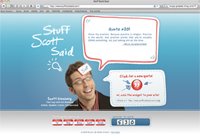 Who’s quoting YOU?
Who’s quoting YOU?
 Business sucks.
Business sucks.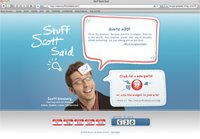 Who’s quoting YOU?
Who’s quoting YOU? The best piece of writing advice I ever got came from the late, great Kurt Vonnegut:
The best piece of writing advice I ever got came from the late, great Kurt Vonnegut: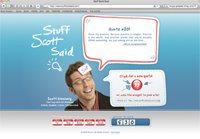 Who’s quoting YOU?
Who’s quoting YOU?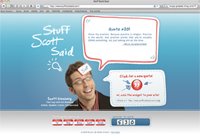 Who’s quoting YOU?
Who’s quoting YOU? How much money is being boring costing you?
How much money is being boring costing you?
 I’ve read 200+ books on creativity, many of which are, ironically, not very creative.
I’ve read 200+ books on creativity, many of which are, ironically, not very creative. Yes, making someone feel “important” and “valued” and “needed” is a HUGE part of being an approachable leader.
Yes, making someone feel “important” and “valued” and “needed” is a HUGE part of being an approachable leader.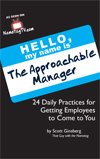
 It’s not about the answer.
It’s not about the answer.
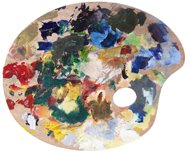 1. Are you allowing yourself to create? It begins with permission. Returning to your childhood. As my friends Kim & Jason say, “
1. Are you allowing yourself to create? It begins with permission. Returning to your childhood. As my friends Kim & Jason say, “